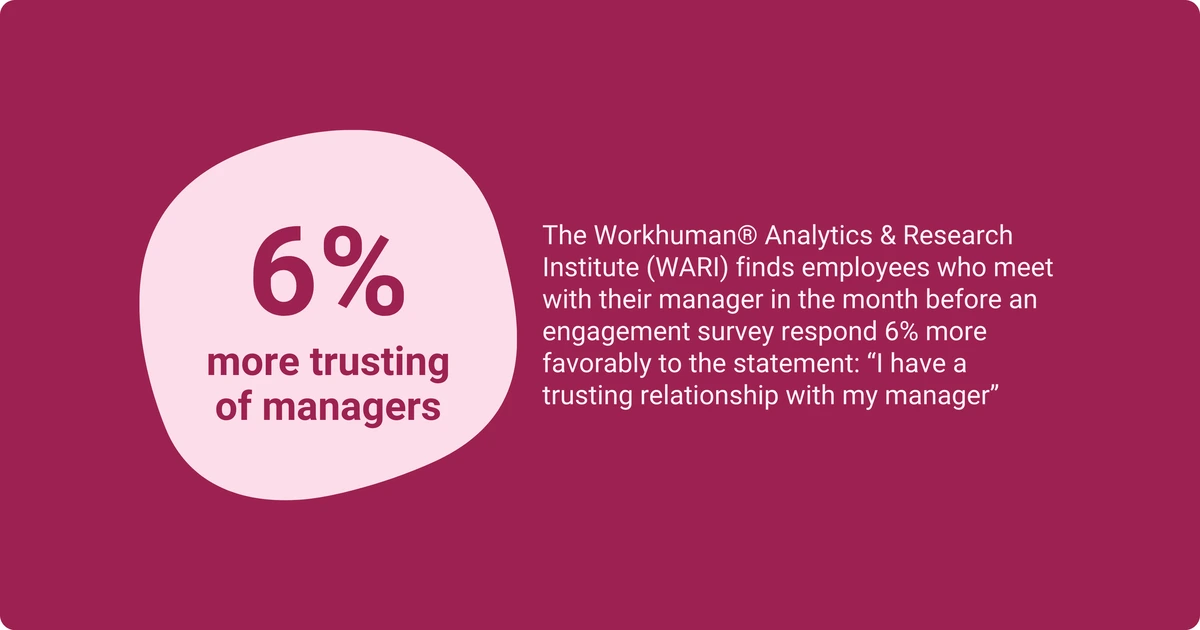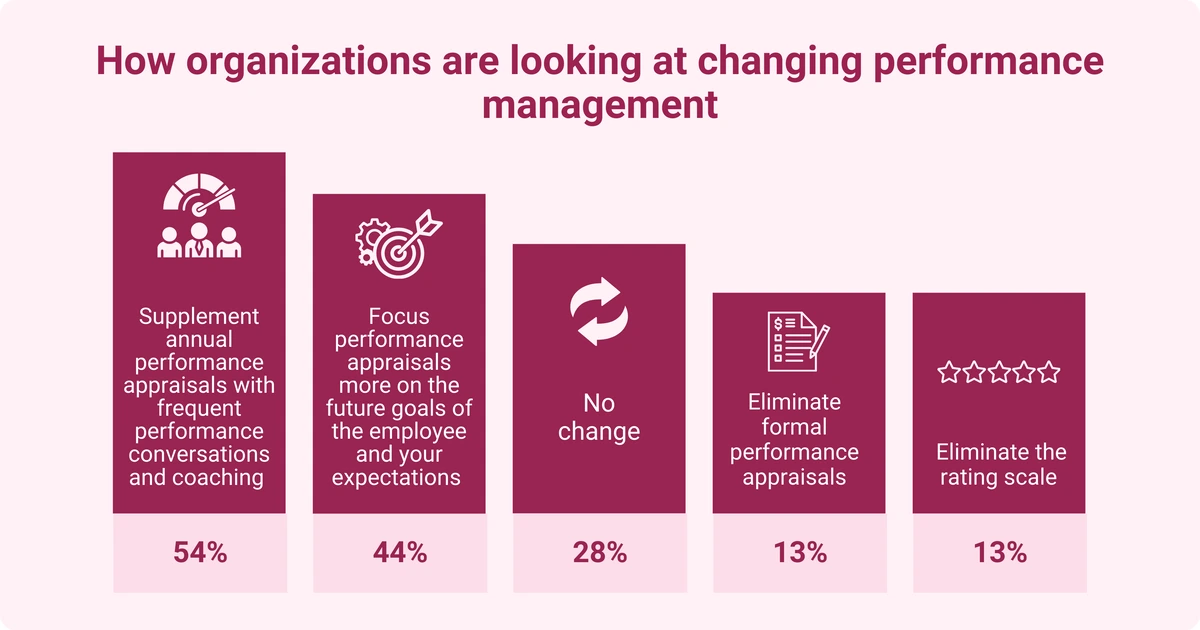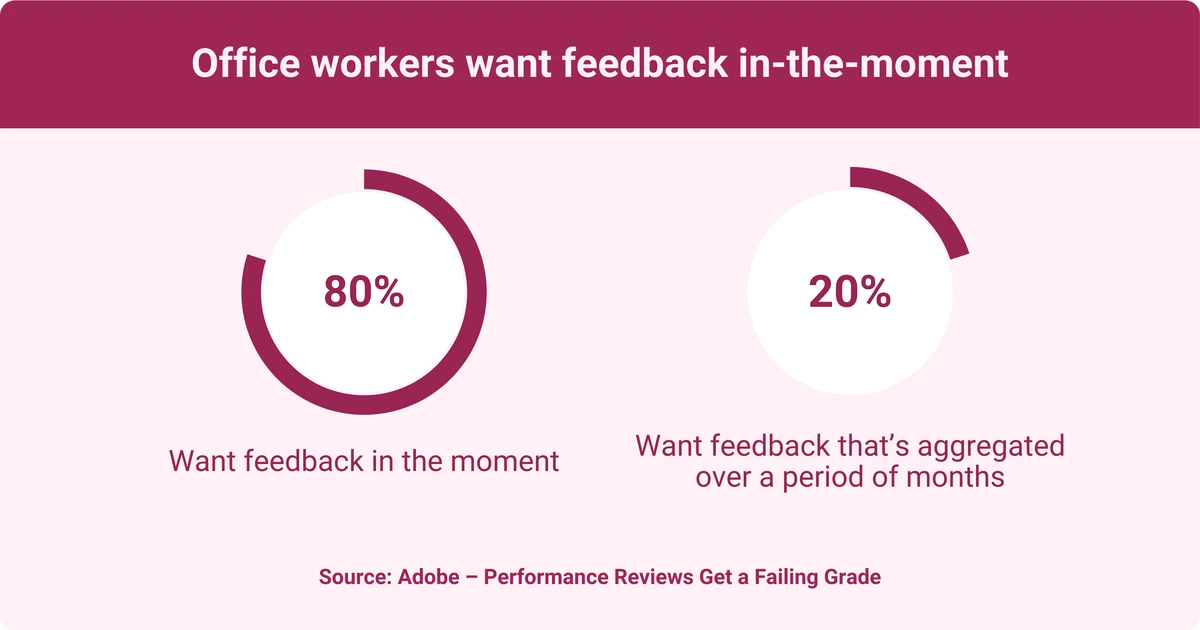Performance Goals Examples: Strategies for Achieving Organizational Objectives
Table of contents
- The importance of performance goals in the workplace
- Department-related examples of performance goals
- Employee-related examples of performance goals
- What are the most commonly used frameworks for setting performance goals?
- Best practices for setting performance goals
- Tracking progress and measuring success
- Employee engagement strategies
- Conclusion

Are you getting the most from your business and employees in 2025? In the Harvard Business Review study "Testing Organizational Boundaries to Improve Strategy Execution", they found that only 20% of companies achieve 80% of their strategic goals.
It's important to understand how to create and manage goals that fulfill your aspirations. Some performance goals examples will help illustrate this.
The importance of performance goals in the workplace
There are many ways to set your employees and organization up for success. One sure way is by designing clear, actionable goals that anyone at any level of the business can follow.
Performance goals are vital for creating a structured and efficient work environment. These objectives act as a bridge between what an organization hopes to achieve and how employees contribute to those ambitions. Defined targets give both employees and employers clarity about expectations.
You can improve employee morale and productivity across your organization when you concentrate efforts in the right direction. Setting clear goals and benchmarks enables you to track progress with tangible results, and that insight allows you to adjust where or when necessary.
For your employees, understanding what is required of them with a clear line of sight to the results they need to achieve gives them a sense of purpose. It can become a big motivator to succeed in their work. Another result will be a more engaged workforce that creates a thriving organization where everyone works toward the strategic vision.
The core purpose of performance objectives is to establish a roadmap. Defining what objectives are important and how they can be achieved will dictate what actions are necessary. Measuring those actions will be vital in understanding how they compare with the roadmap while establishing accountability.
As an employer, this roadmap will be your way to assess growth and identify not only areas of improvement but also areas of opportunity. It will offer employees a sense of accomplishment when milestones are met, which breeds confidence and satisfaction in their roles.
You can also consider what may be important to reaching your goals. Let’s say you want to increase the revenue per sales representative by a certain percentage. Could you improve your outreach strategies or offer additional training to help your employees reach the goal you set?
Department-related examples of performance goals
Every department will require specific targets tailored to the type of work it does. It is imperative to make performance objectives practical and relevant for each role's tasks and priorities. In doing this, you will create focused pathways that lead to growth and success.
Let's take a look at some departments and what tailored performance goals examples look like for them:
Sales and revenue department
It's important to set up your sales goals so the objectives are measured and completed in a given timeframe. They often involve achieving results directly tied to revenue generation and client relationships. There are many types of sales goals. Maybe you would like to:
- Increase monthly or quarterly sales targets by 20%.
- Have each sales representative produce $20,000 in revenue.
- Improve the client acquisition rate by 15% through better outreach strategies or optimized sales pitches.
- Change the balance of cold outreach to an even split between calls and emails as you test what mix brings the best results.
- Strengthen customer retention by implementing a feedback system to address concerns within a set time frame or upselling services to a specific number of existing clients.
Marketing and branding department
Marketing and branding goals often center on creating a lasting impact and driving engagement. Your goals will help you make decisions using data-driven insights that you can deploy through strategic campaigns and across various digital platforms to enhance market visibility and strengthen market positioning.
This will help you remain competitive and resonate with your target audience, creating long-term value and generating loyalty.
When you set clear goals, you will smoothly move customers through the marketing funnel and see what difference your efforts are making.
Maybe you would like to:
- Build brand awareness by increasing social media followers or website traffic by a set percentage over a defined period.
- Generate a specific increase in leads per month by launching targeted campaigns or refining content strategies to appeal to specific audiences.
- Improve campaign effectiveness by testing and optimizing various advertising formats, measuring performance through engagement metrics like click-through rates or conversions.
Customer service team
A Gartner study finds that two-thirds of customers contact customer serviceOpens in a new tab after proactive outreach from a brand. It makes sense then that setting goals focused on delivering exceptional experiences and resolving issues efficiently is critical.
When you look to turn your customer service department into an active component that helps drive the business forward, maybe you want to:
- Reduce the average response times to customer inquiries by implementing faster communication channels or streamlining workflows.
- Increase customer satisfaction scores by actively soliciting feedback and addressing common pain points.
- Shorten complaint resolution time by enhancing problem-solving processes or providing additional training to staff for complex issues.
- Implement an omnichannel strategy that helps transition communications smoothly.
Product development team
Product goals are generally time-bound objectives set bi-annually or quarterly. They are created to support your product vision in a collaborative exercise between the leadership and product teams. They are based on overall product requirements and aligned with business needs.
Once you have defined your product initiatives, you can build out a map and start your product planning. When you consider these goals, maybe you would like to:
- Accelerate product launch timelines by refining development cycles and improving team collaboration.
- Enhance product quality through rigorous testing protocols or incorporating user feedback more effectively.
- Encourage innovation by dedicating time to brainstorming sessions or introducing new tools and technologies to spark creativity.
Human resources
A good organizational culture and a highly motivated workforce stem from a well-thought-out HR strategy. HR goals directly impact everyone in the organization. They need to align with business goals and help employees feel connected to them. When you consider how to future-proof your business, maybe you would like to:
- Improve employee retention rates by introducing robust onboarding programs or recognizing and rewarding top performers, which is made easy by the Workhuman® platform and its Social Recognition® program.
- Streamline recruitment processes by adopting more efficient applicant tracking systems or refining job descriptions for clarity.
- Boost employee engagement through regular surveys or implementing programs that address workplace well-being.
Workhuman is the #1 provider of employee recognition software. When you opt for recognition done right from Workhuman, you don't have to settle for second-rate recognition.

Employee-related examples of performance goals
Everyone wants to feel successful at their job and that they are taking steps toward their career aspirations. It is important to create an employee goal framework that encourages the creation of realistic goals tailored to individual employees while addressing diverse areas of professional growth. This clarity provides direction, increasing productivity.
With a clear path to success, a satisfied employee will contribute to business growth.
Let's look at some examples of employee performance goals examples:
Collaboration and teamwork goals
Building a strong, collaborative team that works well together is essential for achieving your objectives. Here are some actionable tips when setting team goals:
- Increase participation in team meetings by sharing at least one actionable idea per session.
- Enhance collaboration by using shared tools like project management software to streamline communication and task tracking.
- Build stronger interpersonal connections by scheduling monthly peer feedback sessions
- Engage the community by celebrating shared interests through creating cultural events, which is made easy by Workhuman's Community Celebrations feature.
Learn how Community Celebrations® enables everyone to share their celebrations, regardless of their nature, whether personal, cultural, or work-related. Sharing joy on a larger scale makes the event more memorable.
Leadership and management goals
Let's face it: Lack of great leadership and guidance trickles down to employees and severely impacts morale and productivity. Performance goals should focus on guiding teams and driving results effectively. You may consider goals that:
- Provide support and address concerns like holding regular one-on-one meetings with team members
- Develop conflict resolution strategies to manage disagreements promptly and constructively
- Strengthen decision-making abilities by analyzing Key Performance Indicators (KPIs) to make informed choices while offering constructive feedback.
Professional development goals
There is a surefire way to boost job satisfaction and employee confidence while providing workers with career growth: Establish a continuous learning environment that incorporates regular feedback and is aligned with business objectives. Not only will this improve employee skill sets, but it will also keep your teams competitive and boost your business capabilities.
You may consider goals for employees such as:
- Completing a professional certification or attending at least two industry-specific workshops within a set timeframe
- Improving a specific skill, such as public speaking, by enrolling in a relevant training course and practicing in team presentations
- Broadening knowledge by dedicating time each week to reading industry publications or engaging with educational resources like webinars
Productivity and efficiency goals
Encouraging productivity and efficiency requires employees to manage their time and tasks effectively. Setting goals that promote this may look like:
- Reducing task completion time by using productivity techniques like the Pomodoro method or task prioritization frameworks
- Minimizing errors by conducting a self-review of work before submission or implementing quality control checklists
- Improving personal accountability by setting daily goals and tracking progress through productivity apps or journals
Communication and interpersonal skills
Teams with strong communication skills are more likely to be successful in collaborating and building great relationships. Objectives here could focus on:
- Participating in active listening exercises to better understand colleagues and customers
- Delivering clearer messages by practicing concise and structured communication during team meetings or presentations
- Resolving conflicts constructively by learning negotiation techniques and applying them in workplace scenarios
Creativity and innovation goals
Creating a team that can think outside the box can be an excellent way to drive growth or tackle problems. Building a team that's creative and innovative could have goals like:
- Scheduling regular brainstorming sessions with team members to generate fresh solutions for ongoing challenges
- Testing one innovative idea per quarter and assessing its impact on team performance or customer satisfaction
- Attending workshops on creative problem-solving to adopt different approaches when addressing workplace issues
What are the most commonly used frameworks for setting performance goals?
Organizations today lean on specific frameworks to set performance goals because these methods balance structure with flexibility. They align with the fast-paced demands of modern workplaces that require clear structure and adaptability.
Some widely adopted methodologies are SMART (specific, measurable, achievable, relevant, and time-bound) goals, OKRs (objectives and key results), continuous performance management process, KPIs (key performance indicators), and agile goal setting.
Reasons these types are frequently used today
Adaptability: Businesses face rapidly shifting market conditions and ever-evolving customer preferences that coincide with a huge boom in technology advancements. These frameworks keep you agile, allowing you to pivot efficiently. They maintain goal relevancy and are actionable in dynamic environments.
Employee engagement: Modern organizations place greater value on collaboration and transparency. If you include your employees in the goal-setting process, you will create a sense of ownership, motivating them to contribute meaningfully toward shared objectives.
Emphasis on metrics: Data has become central to performance evaluation, whether through OKRs that connect objectives with measurable outcomes or KPIs that monitor specific targets. Metrics help you create a culture of accountability and allow your teams to evaluate progress accurately.
Integration with technology: Goal-setting frameworks help you seamlessly integrate with tools like Asana, 15Five, and Lattice, which simplify the process of tracking progress and refining objectives. These platforms create visibility for your employees and managers alike, promoting a shared understanding of priorities and milestones.
SMART goals
Why it’s popular:
- Clarity and precision: SMART goals stand out for their ability to transform vague intentions into clearly defined and actionable objectives. This specificity means everyone knows exactly what to aim for.
- Universal applicability: SMART goals can be applied across all industries and roles. Examples of SMART goals for work include "Obtain a project management certification by completing the PMP exam before the end of the year” and "Achieve a 10% reduction in the annual employee turnover rate, as measured by HR analytics software."
- Ease of implementation: Unlike more complex frameworks, SMART goals don’t require specialized tools or software. This simplicity allows immediate adoption by anyone, regardless of technical expertise.
Modern relevance:
- SMART frameworks are measurable, which is great when you need specific performance targets. This makes them ideal for tracking progress and celebrating small wins. They really shine in personal development and short-term project deliverables.
OKRs (Objectives and Key Results)
Why it’s popular:
- Focus on outcomes: This framework emphasizes meaningful impact over mere effort, helping teams concentrate on what truly drives success.
- Transparency: By sharing objectives and key results across teams, OKRs promote alignment and create a unified focus within the organization. OKR examples include "Boost employer brand recognition by 15 points to 50" and "Register at least 80% of senior managers in a coaching/mentor program."
- Flexibility: OKRs allow ambitious yet achievable goals while keeping progress measurable. This balance makes them suitable for dynamic environments.
Modern relevance:
- OKRs are widely adopted across all business sizes, from startups to industry giants, and are a staple for tech giants like Google and LinkedIn. Their agile nature encourages collaboration and alignment across departments. This makes them highly relevant for organizations navigating rapid changes and scaling challenges.
Continuous performance management
Why it’s popular:
- Dynamic and adaptive: Unlike rigid, static frameworks, continuous performance management allows goals to evolve as priorities shift so they remain relevant in fluid work environments.
- Employee engagement: They keep employees aligned with organizational objectives through regular feedback sessions and check-ins. This keeps employees motivated and informed while the ongoing communication strengthens their connection to their work.
- Real-time insights: Managers and employees gain timely updates on progress, enabling immediate course corrections or additional support to meet objectives effectively.
Modern relevance:
- Businesses are dropping traditional annual reviews, giving way to continuous performance management systems. They align with the need for faster, more adaptable approaches in industries where change happens rapidly, creating a culture of responsiveness and engagement.

KPI-based goals
Why it’s popular:
- Data-driven decisions: KPI-based goals focus on measurable metrics, such as customer acquisition cost, order fulfillment time, net profit margin, and employee retention rate. They maintain decisions are grounded in quantifiable results rather than assumptions.
- Customizable: KPIs can be tailored to specific job roles, team functions, or organizational strategies, making them versatile for diverse needs.
Modern relevance:
- KPI-driven frameworks are particularly crucial where data is central to operations in industries like finance. It is also perfect for data-thirsty departments like sales and marketing. With the support of business intelligence tools, these goals become even more actionable, helping organizations track and optimize their performance consistently.
Agile goal setting
Why it’s popular:
- Iterative process: Agile goal setting mirrors the principles of agile project management, breaking down objectives into manageable phases or sprints. This iterative approach keeps teams focused on short-term priorities that contribute to long-term success.
- Frequent adjustments: Goals are reviewed and refined at the end of each sprint or project phase, making sure they remain aligned with current challenges and objectives.
Modern relevance:
- Agile goal setting thrives in tech and creative industries where adaptability and teamwork are critical. By embracing flexibility and collaboration, this framework supports innovation and responsiveness, making it indispensable in fast-changing environments.
Best practices for setting performance goals
Here are some guidelines for making performance goals motivating and meaningful to everyone involved.
- Clarity: Clearly define the goals to avoid ambiguity. Employees should understand exactly what’s expected and how their success will be measured.
- Alignment with organizational goals: Tie individual objectives directly to the company’s broader vision. This connection helps employees understand their contributions’ significance.
- Regular review processes: Set up a schedule for revisiting goals. This helps them stay relevant as adjustments are made based on changing priorities or progress updates.
Tracking progress and measuring success
Once goals are set and everyone is on board, success can hinge on keeping track of progress. You need consistent rounds of feedback and adjustments to make sure you are advancing the way you want. Some guidelines to follow:
- Metrics: Identify KPIs and other measurable criteria that directly reflect the goal’s progress. This makes performance quantifiable and easy to evaluate.
- Regular check-ins: Schedule ongoing meetings or reviews to assess how goals are progressing, identify roadblocks, and provide feedback. Frequent updates help in changing course if necessary.
- Adjusting objectives: Be flexible in modifying goals when market conditions or business priorities change. This adaptability keeps goals aligned with what organizational success looks like.
It's important to prioritize feedback in the performance process, which allows employees to course-correct and stay engaged. This drives improvements and contributes to their growth.
Employee engagement strategies
Keeping employees consistently engaged is a challenge for any business. It plays a pivotal role in maintaining a high level of performance, which is essential to achieving performance goals. Here are some strategies to engage your employees:
- Recognition: Regularly acknowledge achievements, big or small. Recognition builds morale and motivates employees to keep working hard while reinforcing positive behaviors.
- Creating a supportive work environment: A workplace culture that values open communication and personal well-being will get the best out of your teams. A positive atmosphere helps employees feel motivated and committed to achieving their objectives.
- Feedback: Providing constructive, actionable feedback helps employees understand their strengths and areas for improvement. It empowers them to develop and grow.

Conclusion
Now that you've thought about successful goal-setting and performance objective examples, what's going to be your next step to empower your teams and get your business thriving in 2025?
Creating performance goals does not have to be complicated. You can explore tools like Workhuman that help keep things simple. However, it's important to remember performance goals do require strategic planning.
They need measurable objectives and a commitment to building an engaged workforce. Make goals clear for all to see and keep them actionable and attainable. With the right frameworks in place, you can build a thriving, results-driven culture.